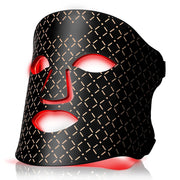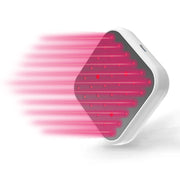Joint pain is one of the main reasons you’ll hear people say, “I used to ski, play tennis, run … (insert an activity you’ve had to give up because of achy knees or hips). Many of the causes that lead to aching joints are treatable with natural methods, including red light therapy.
Plus, natural remedies are often focused on getting to the root of the problem – not just treating pain and swelling – so you’re likely to experience long-lasting relief as the underlying condition resolves.
In this article:
- Why do joints hurt?
- Red light: a surprising (yet scientifically backed) method to relieve joint pain
- Other natural remedies for joint pain
Why Do Joints Hurt?
Knowing why joints hurt is the first step in treating the cause and getting relief. The two most common reasons for painful joints are overuse injuries and osteoarthritis.
Overuse Injuries
What we know as “overuse injuries” are the most common causes of pain. The term refers to injuries that occur from repetitive movements, ramping up activity too fast after time off, or insufficient recovery between workouts.
The human body is designed for a range of movements. Overuse injuries can arise from doing the same movements repetitively, which places disproportionate stress on certain joints and can cause muscle imbalances. These imbalances further aggravate the problem by altering biomechanics, which is how muscles, bones, tendons, and ligaments work together to create movement.
For example, tight and weak adductors with disproportionately strong and flexible quadriceps are a leading cause of chronic knee pain. The quads, which are among the strongest and largest muscles in the legs, pull the kneecap in an outward direction. If their force is not balanced by the adductors (which pull the legs together), the kneecap may fail to track properly when you walk or run. The result can be cartilage degradation over time.
In every joint, muscle strength imbalances cause poor biomechanics which sets off a chain reaction of aching joints, overcompensation, and more aching joints.
Pain arises when the cartilage that cushions the joint wears down and becomes thin, causing excruciating pain; even slightly worn-down cartilage can cause chronic low-grade pain.
Osteoarthritis
Osteoarthritis is the most common type of arthritis. This degenerative disorder is often caused by overuse and repetitive motions and may not manifest for many years. According to the Mayo Clinic, nearly 80 percent of injured football players will likely develop osteoarthritis within 10 to 30 years of the injury – distressing news for anyone who has had a knee, shoulder, hip, elbow, or ankle injury.
Since the mechanics of every joint directly affect the mechanics of other joints, problems in one joint can escalate from localized pain to general musculoskeletal problems.
People who suffer from overuse injuries and osteoarthritis may use a variety of treatments to help with healing and pain relief, including natural treatments like red light therapy. Learn more about red light therapy for facet joint pain.
Red Light Therapy for Joint Pain
Also known as low-level light therapy (LLLT) or photobiomodulation, red light therapy has proved to be a potent treatment for a variety of joint disorders. Whether pain stems from an overuse injury, osteoarthritis, inflammation (bursitis), dislocation, or even traumatic injury, red light shows promise to help.
You may wonder, how does shining a light on a painful joint help ease the pain? Many people aren’t aware of just how powerful that light is.
For centuries it has been known that the human body is highly responsive to light. Ancient healers used natural sunlight to treat a variety of ailments. During the late nineteenth century, scientists discovered that what appears to be warm-white light from the sun is actually an entire spectrum of colors.
Today, it is known that each color is a wavelength of a different size, and each affects the body differently. Hundreds of studies have shown that red light benefits the body in numerous ways, while being gentle and completely safe.
The term “red light” encompasses both red and near-infrared (NIR) wavelengths. Research has shown that the most beneficial wavelengths for healing are between 620 nanometers (nm) and 660nm (red), and between 810nm and 850nm (NIR). This range is often referred to as the “therapeutic window.”

Other Natural Remedies for Joint Pain
To help ease symptoms of joint pain, you could also try these natural remedies.
- Manage your weight
Excess weight adds a lot of pressure on your joints, especially those in the torso and lower body. Work with your doctor to set an ideal weight and formulate a program to reach your goal.
- Keep moving
A well-rounded exercise program will help keep the joints lubricated and develop even muscle tone. A combination of strength training, walking, cycling, yoga, and swimming is a great way to build strength.
- Add turmeric to your diet.
This natural anti-inflammatory root is what gives curry its golden hue. Its main ingredient, curcumin, has both anti-inflammatory and antioxidant properties and has been shown to reduce pain and arthritis-related inflammation.
- Alternate heat and cold.
Alternating ice and heat can ease stiffness and increase blood flow to the area.
- Eat a healthy diet.
A plant-based diet is rich in antioxidants and anti-inflammatory substances. Avoid a diet high in red meat and sugar, both of which are known to aggravate inflammation.
- Add herbal supplements.
Some herbs may be effective analgesics. These include bromelain, thunder god vine, ginkgo, and stinging nettle. Even black pepper has analgesic properties. But remember, always consult your doctor before adding any supplements because of the danger of drug interactions.
- Add glucosamine, chondroitin, and MSM.
This popular approach can support joint health. Both glucosamine and chondroitin sulfate are present in normal cartilage and may stimulate the body to produce more cartilage. However, studies about the effect of glucosamine and chondroitin sulfate on pain show mixed results.
The main effect seems to be long-term. Some doctors recommend taking glucosamine and chondroitin sulfate for three months. If there is no apparent improvement, it’s reasonable to stop taking these supplements.
Methylsulfonylmethane (MSM), is a supplement often used to treat arthritis pain. This natural sulfur compound is naturally in the body. This anti-inflammatory and pain-relieving compound is essential for healthy connective tissue and joint function. As with glucosamine and chondroitin, the effects of MSM may become more apparent over time.









